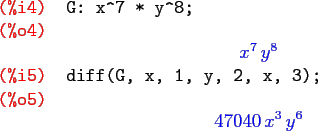Next: Linear Approximation and Differentials Up: Functions of Several Variables Previous: Functions of Several Variables Contents
We do partial derivatives in the natural way. For example, for the partial derivative with respect to ![]() we do
we do

The long way to get higher order derivatives is to nest the diff calls. The second order partial derivative is

and the second partial with respect to ![]() then
then ![]() is
is

For higher order partial derivatives a quicker way is to do

The above first differentiates ![]() with respect to
with respect to ![]() three times, then with respect to
three times, then with respect to ![]() two times, and finally with respect to
two times, and finally with respect to ![]() one time; that is, the arguments match the Leibnitz notation for partial derivatives.
one time; that is, the arguments match the Leibnitz notation for partial derivatives.